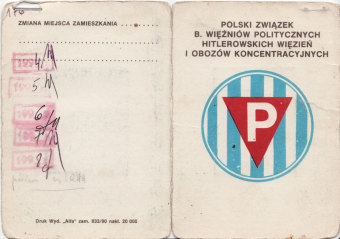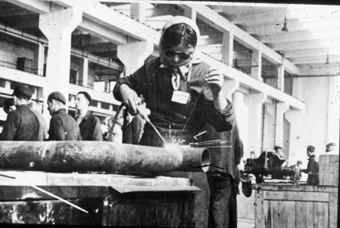Origin and Number of Foreign Civilian Laborers and Forced Laborers

© Jerzy Kowalewski

© Fritz Bauer Institute (Zahn papers)
The authorities sought to relieve the labor shortage in the “Third Reich” by recruitment and forcible conscription of foreign workers. The military campaigns and the conquests of neighboring European countries were accompanied by enlistment of the civilian population as a workforce. These laborers either worked in plants in the occupied countries or were sent to Germany to work. By the end of 1944, about 8.2 million foreign civilians and prisoners of war, as well as 700,000 concentration camp prisoners, had entered the German Reich as workers. The foreign civilian laborers had come voluntarily to Germany, often under the pressure of high unemployment in their countries of origin. They were subject to very strict rules and frequently lived in very poor conditions. The forced laborers were in Germany against their will. They came from the following countries:
Czechoslovakia:
In early 1939, the German Reich began recruiting skilled personnel from the area of Czechoslovakia. By late June 1939, about 52,000 Czechs had come to the Reich. By the end of the war, a total of 340,000 to 370,000 Czech men and women were part of the workforce in Germany, either voluntarily or, as in most cases, against their will.
Poland:
About 420,000 Polish soldiers were in German captivity. Most were released after a short time, and as a result they lost the protection of the provisions of the Geneva Convention. Subsequently, 200,000 of them were forced into employment. In addition, Polish civilians were picked up during raids and deported to Germany for forced labor. As early as September 1939, this fate befell 10,000 people. In September 1941, around 1 million Polish workers were registered in the German Reich. Of the total of 2.2 million Polish men and women who worked in Germany during the war, only about 5 percent came there as volunteers. In addition, about 1.1 million were deployed as laborers in the “Reichsgau Wartheland”; overall, therefore, more than 3 million Poles were conscripted for forced labor in the territory of the “Greater German Reich.” Moreover, after late 1940 at least 700,000 Jews in ghettos and forced labor camps were forced to work for German firms or for the Wehrmacht.
Denmark:
About 80,000 people from Denmark, which was occupied on April 9, 1940, worked in Germany, most of them as volunteers. Because they were classified as “Germanic,” they could count on acceptable working conditions.
Netherlands:
As of March 1942, workers could also be taken to Germany as labor conscripts. In addition, infrequent raids took place until 1943. In September 1944, the German occupation authority in the Netherlands began to engage in labor conscription on a massive scale. In its course, 140,000 Dutch citizens were requisitioned and taken to Germany in the space of a few days, and 120,000 more were used to dig trenches and build fortifications in northeastern Holland. Overall, there were between 350,000 and 400,000 Dutch forced laborers in the German Reich when the war ended, and 100,000 of them had come before 1940, largely voluntarily.
Belgium:
By summer 1941, 189,000 workers had come from Belgium to Germany, initially on a voluntary basis. After the introduction in October 1942 of a nationwide obligation to work, they were followed by others—an additional 200,000 by 1945—as forced laborers.
France:
In addition to the approximately 2 million French men and women who were conscripted for labor in occupied France, about 185,000 were recruited for work in Germany by spring 1942. In April 1942, nationwide conscription began, and a program known as the Service Obligatoire de Travail (STO, Compulsory Work Service) was institutionalized in February 1943. By the war’s end, around 1 million civilians had come to the German Reich as laborers. Around 600,000 POWs were added to that number by September 1944.
Yugoslavia:
Even before the German invasion of Yugoslavia in April 1941, there were 47,000 Croats and Slovenes working in the German Reich. After that time, recruitment of workers began, and by the war’s end there were about 100,000 Croatian men and women from the Kingdom of Yugoslavia working in Germany, mostly on a voluntary basis, however. Around 110,000 Serbian and Slovenian prisoners of war were deported to Germany for deployment at labor, and an additional 100,000 Serbian civilians came “voluntarily,” to avoid forcible conscription for work in Serbian mines.
Greece:
After the occupation of Greece in April 1941, the German occupation authority forced around 20,000 Greek men and women on Crete to work for the Germans, to a large extent under harsh conditions in the mines in the northern part of the island. After that, an additional 100,000 Greeks—including even 16-year-olds, starting in 1943—were requisitioned to work for the German Wehrmacht. Despite extensive recruitment efforts, only 23,000 Greek men volunteered to go to Germany, while 12,000 others came there as forced laborers and 1,000 as POWs.
Soviet Union:
In late 1941, Hitler endorsed the work deployment of Soviet POWs in Germany as well, a step he previously had ruled out categorically. After introducing nationwide compulsory labor in December 1941, the occupation authorities engaged in forcible recruitment. As this still did not yield the desired numbers of workers, the Germans went on “slave hunts”[1] in which people were indiscriminately seized on the street and deported. In the so-called Heuaktion (Hay Action) in March 1944, 28,000 boys and girls between the ages of 10 and 14 were “harvested” in the Soviet Union and deported to Germany. Overall, the German occupation authorities used 22 to 27 million Soviet men and women for forced labor (including Jews); about 2.8 million Soviet civilians and some 630,000 POWs were deported to Germany for this purpose.
Italy:
Italian workers, as citizens of an allied fascist state, enjoyed a special position at first. Between March 1941 and December 1942, around 250,000 Italian industrial workers came to Germany. As of March 1943, at Mussolini’s command, they were supposed to return to Italy. After his overthrow in July 1943 and the German occupation of Rome, the German administration refused to permit the return of the Italians still working in Germany. After a wartime labor conscription of several age groups, the Germans later switched to a policy of forced labor as well. Overall, another 100,000 civilians from Northern Italy and 600,000 so-called Italian military internees were deported to Germany by 1945.
Hungary:
Hungary had been one of the allies of the Nazi regime since the 1930s. Overall, around 40,000 Hungarian men and women worked in Germany as volunteers. It was primarily the Jewish population that was used for forced labor, to the extent that its members were not deported to Auschwitz between April and July 1944.
Other Groups of Forced Laborers:
Other workers, both men and women, came from Bulgaria (about 30,000), Romania (fewer than 9,000), Spain (several thousand), and Switzerland (16,000–18,000). In addition, British (100,000) and some American prisoners of war were deployed as laborers.
(BG/SP; transl. KL)
















